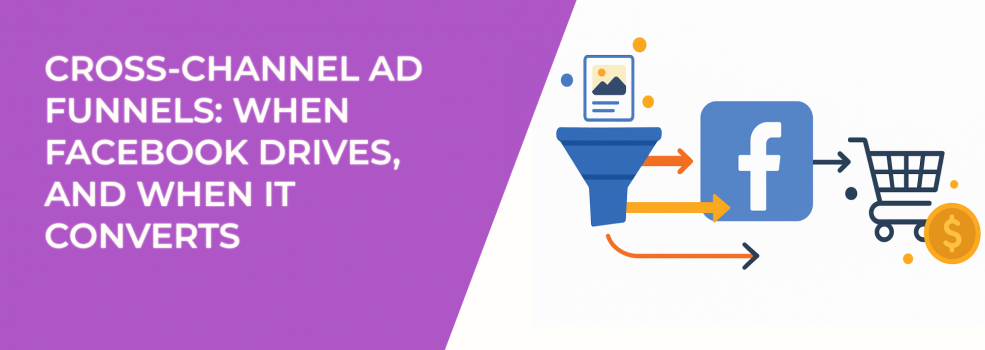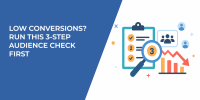In digital advertising, relying on a single channel is a gamble few businesses can afford. Buyers today are scattered across platforms, scrolling on Facebook, searching on Google, or opening emails from trusted brands. Cross-channel ad funnels allow you to meet them where they are, guiding their journey from awareness to action in a structured, intentional way.
Facebook plays a unique role in this journey. Sometimes it acts as the driver, sparking awareness and pulling prospects into the funnel. Other times, it becomes the closer, securing the final conversion when the timing is right. Understanding when to let Facebook drive and when to let it convert can make the difference between wasted spend and consistent ROI.
Why Cross-Channel Funnels Matter
Consumers don’t think in terms of “channels.” They see a product on Facebook, compare alternatives on Google, check reviews on Instagram, and maybe click an email before buying. A campaign that assumes one touchpoint can handle all these steps is destined to underperform.
That’s why cross-channel funnels matter. They don’t just diversify your ad spend — they align your messaging with the natural rhythm of decision-making. Instead of forcing prospects down a rigid path, you create a sequence of interactions that feels natural, even seamless.
For marketers building out these structures, it helps to revisit strategies such as a full Facebook Ads Funnel Strategy. That way, every platform supports the journey without competing for the same role.
When Facebook Is the Driver
Facebook’s strength lies in its unmatched ability to generate awareness. With billions of users and advanced targeting tools, it’s an ideal driver of early-funnel activity. If your goal is to introduce your brand, capture attention, or simply get people curious, Facebook is your engine.
Here are some effective scenarios where Facebook should drive:
-
Launching a new product: Use short, eye-catching videos to spark curiosity among audiences who didn’t even know they were looking for a solution. For inspiration, see how to promote a new product on Facebook using interest targeting.
-
Building remarketing lists: Driving initial traffic to your site or app ensures you’ll have a pool of warm leads to re-engage later.
-
Shaping perception: Storytelling ads, especially carousel or reel formats, allow you to frame your brand narrative before competitors define it for you.
Driving doesn’t mean you’ll see immediate sales. But it does mean you’ve planted the seed. And in digital advertising, planting seeds is half the battle.
When Facebook Converts
Awareness alone doesn’t pay the bills. At some point, prospects need to take action—and Facebook can be a surprisingly strong conversion tool when used strategically.
These are situations where Facebook thrives as a closer:
-
Retargeting warm audiences: If someone visited your product page or abandoned their cart, a timely retargeting ad often reignites their interest. Check out our guide on how to set up Facebook retargeting for best practices.
-
Showcasing social proof: Ads featuring customer reviews, testimonials, or influencer content help eliminate doubts that stall conversions.
-
Creating urgency: Countdown offers, event reminders, or limited-time promotions can push hesitant prospects to finally act.
The psychology here matters. People are more likely to buy when they already know you. Facebook’s granular retargeting tools let you capitalize on that moment of familiarity.
The Balance Between Driving and Converting
Many advertisers run into trouble when they expect Facebook to do everything. A single campaign trying to build awareness, educate, and sell rarely works. Each stage requires a different message, creative format, and audience strategy.
The smarter move is sequencing. Imagine this flow:
-
Facebook introduces the product to a cold audience.
-
Google Search captures intent when users start researching.
-
Email marketing nurtures interest with more detailed content.
-
Facebook retargeting delivers the final nudge with a discount or testimonial.
When Facebook plays both ends—driving at the top and converting at the bottom—you’re maximizing its strengths without overloading it.
If you’re unsure how to design such flows, you may want to explore the full Facebook funnel strategy, which breaks down each stage with clarity.
Practical Tips for Cross-Channel Ad Funnels
Cross-channel funnels don’t work by accident. They require planning, testing, and ongoing refinement. If you want your funnel to run smoothly, keep these best practices in mind:
-
Align your creative: A Facebook ad that emphasizes speed should lead to a landing page that proves it, not one that focuses on price. Consistency builds trust. For help, see crafting compelling Facebook ads copy that converts.
-
Map the sequence: Awareness on Facebook, research on Google, nurturing via email, conversion back on Facebook — your funnel should guide users in a logical flow.
-
Track with precision: Use UTMs, pixels, and CRM integration to see exactly where users come from and what drives action. Without tracking, your funnel is just guesswork.
-
Test and refine: Expect friction. Maybe your video ad drives clicks but your landing page bounces. Instead of scrapping the funnel, tweak the weak link.
The goal isn’t perfection on the first attempt — it’s progress with every iteration. Over time, you’ll spot patterns that reveal which channels drive and which convert most effectively for your audience.
Critical Insights for Marketers
It’s tempting to see Facebook as either an awareness tool or a conversion machine. The reality is more nuanced. The same platform can fill both roles, but not with the same audiences or the same creative.
-
Cold audiences respond better to storytelling and education. Trying to sell too soon risks alienation.
-
Warm audiences are primed for action, but they need reassurance. Show them proof, urgency, or exclusivity.
-
Budget allocation should shift over time. You may spend more on driving during product launches and lean heavier into conversions during peak sales seasons.
If you’re wondering whether this investment is worthwhile in 2025, you might also want to check out Are Facebook Ads Worth It?.
Cross-channel funnels aren’t just about spreading your ads across platforms. They’re about orchestration — ensuring each touchpoint plays its part in the larger symphony of customer acquisition.
Final Word
Facebook can drive. Facebook can convert. But asking it to do both at the same time in the same campaign is a mistake many marketers still make. Cross-channel funnels solve that problem by letting each platform shine where it’s strongest.
The advertisers who succeed aren’t the ones with the biggest budgets. They’re the ones who design smart funnels, respect the buyer journey, and adapt as behavior shifts. When you get that balance right, you’ll see the difference—not just in clicks or impressions, but in real, measurable conversions.

